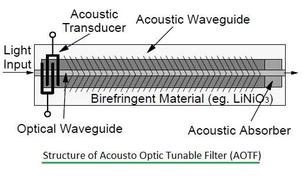Acousto-Optic Modulator Frequency Shift Explained
This document explains the Acousto-Optic Modulator (AOM) frequency shift and provides the relevant formula.
Introduction
Acousto-optic modulators operate based on the acousto-optic effect. This effect involves modulating the optical properties of a medium by varying its refractive index under the influence of an acoustic wave.
What is an Acousto-Optic Modulator?
Acousto-optic devices rely on the photo-elastic effect, which describes the interaction of acoustic waves and light within a crystalline material. Acoustic waves are generated within the crystal by applying an RF drive signal to a piezoelectric transducer. This process creates areas of compression and refraction within the crystal’s bulk, leading to periodic changes in the refractive index. Consequently, light entering the AO device is diffracted into multiple orders at the output.
The acoustic wave travels from the transducer to an absorber to prevent secondary diffractions caused by reflections. Most acousto-optic devices are designed to maximize the diffraction of the input laser beam into a single, first-order position. When the AO device is correctly aligned and the drive power is adjusted to or below the RF saturation level, it’s said to be operating in the Bragg regime.

Acousto Optic Modulator
Acousto-Optic Modulator Frequency Shift Formula
The diffracted beam experiences a frequency shift relative to the incident laser beam. This shift is equal to the RF frequency (). By adjusting the AOM’s orientation relative to the incident beam, the diffracted beam can be produced at frequencies or .
The Acousto optic modulator frequency shift formula is as follows:
Where:
- is the laser frequency.
- is the RF frequency used to produce the acoustic wave.
The frequency shift is a consequence of momentum conservation during the interaction between the laser beam and the acoustic wave.
 RF
RF


